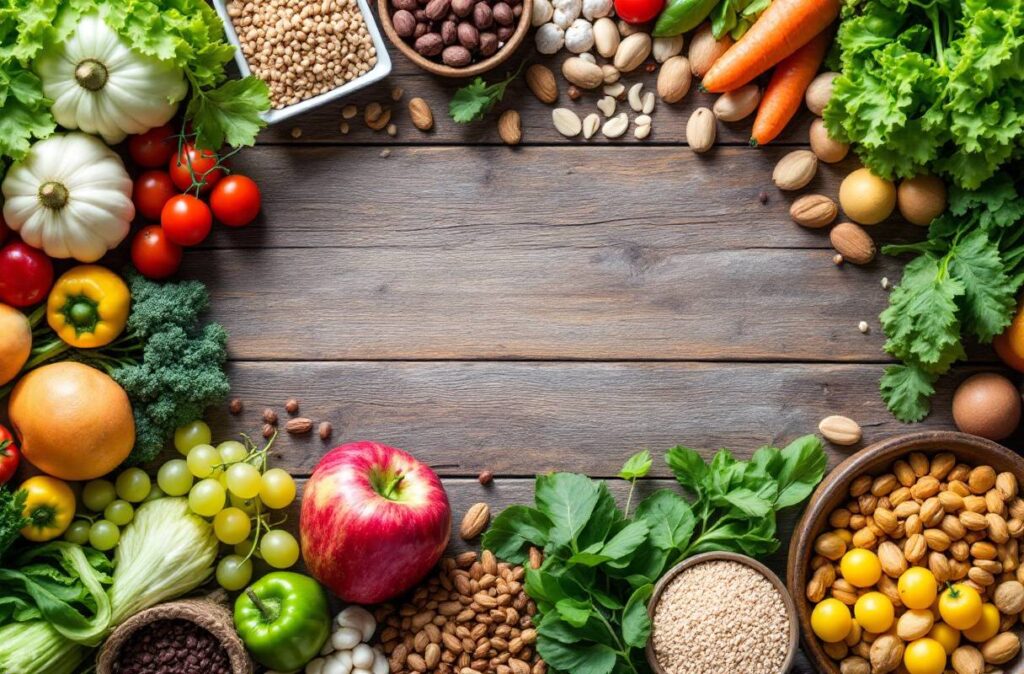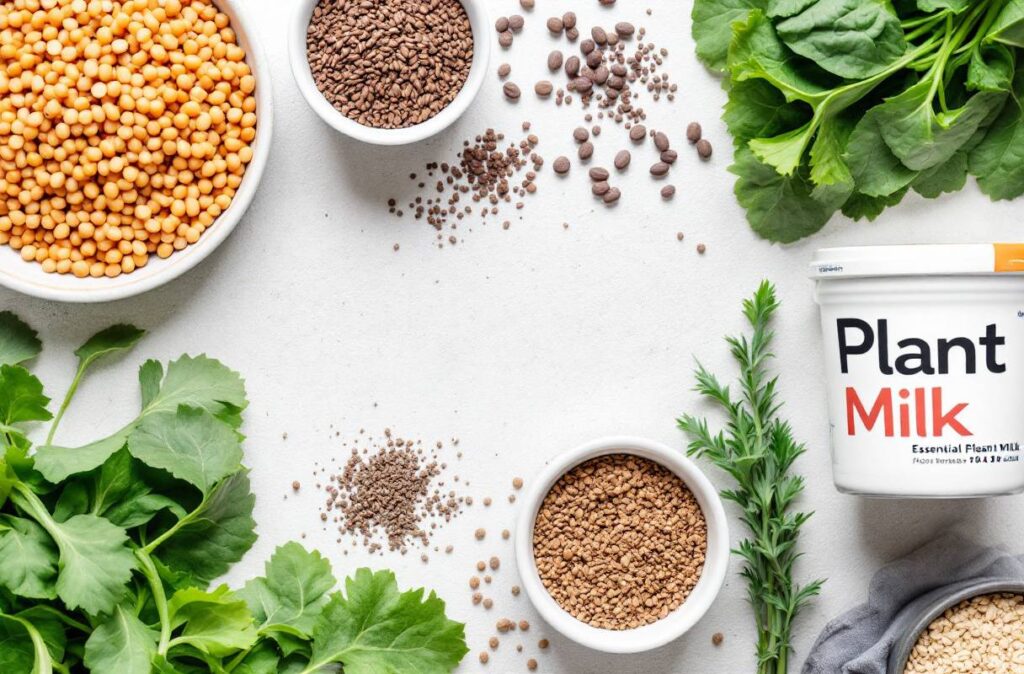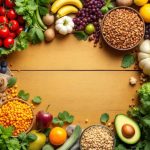Are you ready to transform your health and make a positive impact on the planet? Transitioning to a Plant Based Diet might be the change you’ve been searching for.
Imagine savoring vibrant, flavorful meals that not only nourish your body but also contribute to a more sustainable world.
Whether you’re a busy parent sneaking veggies into dinner or a health enthusiast looking to optimize your nutrition, embracing a plant-based lifestyle offers a delicious path to wellness and environmental stewardship. Let’s explore how planting these dietary seeds can lead to a flourishing life!
Plant-Based Diets Explained
Alright, let’s chat about plant-based eating! At its heart, it’s all about munching on things that grow. This isn’t just for the super health nuts either. Parents, wanna sneak some veggies into dinner without the drama? This one’s for you too.
Understanding Plant-Based Eating

When we talk about a plant-based diet, we’re basically saying: eat more of the good green stuff. Fruits, veggies, nuts, seeds, oils, whole grains, beans — you name it! Whether you’re cutting out animal products completely or occasionally indulging, it’s totally your call.
What’s the big deal with whole foods? It’s eating food in its natural form, not a science experiment gone wrong (Piedmont Healthcare).
What’s cool about plant-based diets?
- Say hello to fiber! Keep things moving, if you know what I mean.
- Load up on vitamins and minerals.
- Low on the bad stuff—think calories, fats, cholesterol.
- Plants can give you all the protein and calcium you crave.
No Vitamin B12 shortage here, just pop a supplement or go for some fortified goodies like cereals and plant milk.
| Nutrient | Get It From Here |
|---|---|
| Protein | Beans, nuts, tofu belly |
| Calcium | Leafy greens, almond drink |
| Iron | Lentils, pumpkin seeds |
| Vitamin B12 | Fortified cereals, supplements |
Interested in something like the Mediterranean vibe? It’s got plant foods, fishies, and dairy. This diet is like nature’s multitasker—great for your heart, keeps your metabolism in check, and might even keep some nasties like cancer at bay (Harvard Health Publishing).
Jumping into a plant-based thing doesn’t have to feel like a kitchen nightmare. Check our how to start a plant-based diet article for easy peasy tips. A sprinkle here and there can give you the health perks and make Mother Earth happy too. Whether you’re sniffing out plant-based iron sources or the best plant-based protein, we’ve got a gold mine of info to get you started.
Need more?
- best plant-based protein
- how to start plant-based diet
- plant-based iron sources
- plant-based calcium foods
- plant-based diet supplements needed
- plant-based diet weight loss
- plant-based athlete diet
- plant-based meal prep
- cheap plant-based diet
- easy plant-based breakfast
- plant-based diet side effects
- plant-based snack ideas
- plant-based omega 3 sources
- plant-based vs vegan
- best plant-based protein powder
- best plant-based meal delivery
- best plant-based cookbooks
- best blender for plant-based diet
- best plant-based supplements
Benefits of Plant-Based Diets
Shifting to a plant-based diet brings tons of perks—it’s not just about keeping you in tip-top shape, it’s giving Mother Earth a helping hand too.
Health Benefits
Jumping on the plant train can sprout a garden of health boons. Munching on the goodies like veggies, fruits, whole grains, legumes, and nuts won’t just make your taste buds do a happy dance, it also slashes your chances of tangoing with heart disease. It can even make a heart condition back off, boost your good cholesterol, and keep that blood pressure in check (WebMD).
But wait, there’s more! This diet may help your odds with certain cancers, including the ones affecting the breast, prostate, and gut.
Got sugar troubles? A plant-based plate could shrink your diabetes risk by 34%, dialing in your blood sugar, shedding some pounds, and keeping that cholesterol level where it belongs.
| Health Perk | What It Does For You |
|---|---|
| Heart Health | Fewer heart woes, better cholesterol, calm blood pressure |
| Cancer Risks | Keeps breast, prostate, and gut cancers at bay |
| Diabetes | Cuts risk by 34%, better blood sugar control |
New to the greens scene? Get comfy with our guide on starting a plant-based diet for a smooth ride.
Environmental Impact
Giving plants the star role on your plate? You’re not just being kind to critters, but you’re shrinking your carbon sneakers too. Recent scoop says this switch might chop greenhouse gases by 70%, cut water use in half, and shave land use by another 70% compared to the regular Western spread.
Ditching meat for greens means less deforestation, a lighter energy bill, and less junk polluting the air. It’s a personal power move to ease climate troubles and keep our planet looking fine.
| Earth-Friendly Perk | The Big Picture |
|---|---|
| Greenhouse Gases | Down by 70% |
| Water Consumption | Down by 50% |
| Land Usage | Down by 70% |
Hunting for budget-friendly greens? Peek at our tips for a cheap plant-based diet.
Curious about keeping up your nutrients game? Dive into our scoop on plant-based iron sources and plant-based calcium foods.
Grabbing these benefits means looking after yourself while also a nod to a more sustainable life—plant power really packs a punch.
Types of Plant-Based Diets
Taking a stroll through the world of plant-based diets can fill your plate with all kinds of options and tasty rewards. Here, we’ll chew over the differences between vegan and plant-based diets, and see how the Mediterranean diet mingles in this mix.
Vegan vs. Plant-Based
Vegan and plant-based diets might seem like twins, but they’re more like cousins with their own quirks.
Vegan Diet: Skip anything that once had a pulse or came from something that did. That means dairy, eggs, and honey are no-gos. Going vegan is a big high-five to animal rights and often extends to lifestyle choices like saying ‘nope’ to leather.
Plant-Based Diet: This one shines a spotlight on the greens – think luscious fruits, veggies, legumes, nuts, seeds, and whole grains. It might sneak in a fish fillet or a slice of poultry here or there, but the veggies are the headliners for health and saving Mother Earth.
| Aspect | Vegan Diet | Plant-Based Diet |
|---|---|---|
| Focus | Ethical stance on animal rights | Health focus and eco-friendliness |
| Animal Products | Cut out entirely | Kept low-key but not banned |
| Processed Foods | Typically avoided, but some might slip in | Whole and unprocessed are the stars |
Both diets are like different routes to a healthier you. Wanna dive deeper? Check out plant-based vs vegan for all the juicy details.
Mediterranean Diet Comparison
The Mediterranean diet is like the older, more experienced sibling with plant-based vibes but isn’t afraid of a bit of fish or cheese. Here’s the lowdown:
- Plant-Based Foods: Load up on fruits, veggies, whole grains, nuts, seeds, and legumes.
- Animal Products: Fish, poultry, eggs, cheese, and yogurt get to play too, just not too much.
As per Harvard Health Publishing, this scrumptious setup might just give heart disease, diabetes, and some cancers a one-two punch while keeping the old-timers spry.
| Aspect | Mediterranean Diet | Plant-Based Diet |
|---|---|---|
| Major Components | Loves plant foods, includes fish, poultry & dairy | Mostly plant foods with wiggle room |
| Health Benefits | Tackles chronic illnesses like a pro | Boosts overall health vibes |
| Flexibility | Mixes in moderate animal foods | Focus mainly on plant goodies, but not strict |
Getting the scoop on these diets means you can find the one that sings to your taste buds and soul.
Dig into how to start a plant-based diet and feast on budget-friendly meal ideas or whip up easy plant-based breakfasts.
Nutritional Considerations

Essential Nutrients Overview
Switching to a plant-based diet can be exciting and rewarding, but you gotta keep track of some key nutrients to stay shipshape. We’re talking about protein, iron, calcium, omega-3s, vitamin B12, and zinc.
| Nutrient | Plant-Based Goodies |
|---|---|
| Protein | Lentils, chickpeas, quinoa |
| Iron | Beans, lentils, peas, tempeh, leafy greens |
| Calcium | Leafy greens, fortified plant milks (plant-based calcium foods) |
| Omega-3s | Flaxseeds, chia seeds, hemp seeds |
| Vitamin B12 | Supplements, fortified foods |
| Zinc | Whole grains, nuts, seeds |
Keeping an eye on these nutrients can keep you hale and hearty. Curious about protein options? Check out best plant-based protein for some tasty ideas.
Potential Deficiencies
Sometimes, a plant-based lifestyle might miss out on certain nutrients. Being aware and tackling these gaps head-on can keep things running smoothly.
Vitamin B12
Vitamin B12 plays hide and seek mostly in animal stuff, so folks on a vegan path should think about those B12 supplements. Without it, you might feel worn-out and it could mess with your brain too (Healthline).
| Symptom of Deficiency | Risk |
|---|---|
| Being tired all the time | High |
| Memory slips | Moderate |
Iron
Iron’s your red blood cell buddy. Plant-sourced iron takes some persuading to be absorbed but teaming it up with vitamin C-rich pals can help give it a boost.
| Food | Iron Content (mg) per 100g |
|---|---|
| Lentils | 3.3 |
| Spinach | 2.7 |
| Fortified Cereals | 8.0 |
Get the lowdown on more plant-based iron sources if you’re digging into this further.
Iodine
Iodine’s got your thyroid back. Sea veggies, iodized salt, and multivitamins can help you keep it topped up; just don’t overdo it and go into overdrive.
Omega-3 Fatty Acids
Omega-3s are all about that brain and heart magic. Flax meal and chia seeds are fab, but algae oil supplements make sure you’re all set. Look up plant-based omega 3 sources for more brain food.
Vitamin K2
Vitamin K2 is the hero for bones and heart tickers. It’s found in fermented foods and select supplements, so aim for 10-40 micrograms daily.
Choosing foods wisely and considering supplements in your plant-based adventure can keep you feeling snazzy. For extra pointers, the scoop on plant based diet supplements needed will give you the edge.
Transitioning to Plant-Based
So, you’re thinking about starting a plant-based diet? It might seem scary at first, but trust me, it’s a lot easier than it looks! Here’s a basic rundown of some easy food swaps and meal tips to make your switch as smooth as your grandma’s mashed potatoes—minus the butter.
Simple Substitutions
Swapping your regular grub for plant-based alternatives is a no-brainer. Here are some go-to switches that’ll get you rolling:
| Traditional Ingredient | Plant-Based Alternative |
|---|---|
| Cow’s Milk | Almond Milk, Soy Milk, Oat Milk |
| Ground Beef | Lentils, Black Beans, Tofu |
| Chicken | Tempeh, Seitan, Jackfruit |
| Cheese | Nutritional Yeast, Vegan Cheese |
| Eggs | Chia Seeds, Flax Seeds, Tofu Scramble |
These swaps don’t just make dishes guilt-free; they keep your meals tasty while making sure you’re getting those good nutrients in. Dig into our best plant-based protein article for all the juicy details.
Meal Planning Tips
Let’s talk meal prep hacks to keep your tummy—and schedule—happy:
- Plan Ahead: Map out a week of meals and snacks so you don’t end up gnawing on random junk food when hunger strikes. Our plant-based meal prep guide is your best friend here!
- Batch Cooking: Cook ginormous batches of grains, beans, and veggies. Having these on hand means you can whip up a healthy meal faster than you can say “fast food”. Your week-in-a-bowl game will be strong.
- Balance Your Plate: Chow down on meals that mix proteins, healthy fats, and carbs. Think legumes, nuts, seeds, and all sorts of whole grains. They’ll keep you satisfied and smiling.
- Keep it Simple: Start with easy-peasy recipes using ten ingredients or less. Fast cooking, fast eating. For ideas, take a gander at our easy plant-based breakfast suggestions.
- Smart Snacking: Munch on plant goodies like fruits, nuts, and veggie sticks dipped in hummus. Keeps your energy up and hunger down. More ideas? Look at our plant-based snack page.
Pop these tips into action, and you’ll breeze through your plant-based change like a pro. For a little backup, get to know about possible plant-based diet side effects and the supplements you might need to keep all your nutrients in check.
Plant-Based Recipes
Trying out plant-based dishes is like opening up a treasure chest of flavors, especially for folks just dipping their toes into this diet. Here are some easy, wallet-friendly recipes to get you cooking without a fuss.
Easy Vegan Breakfasts
Kickstart your day with a breakfast that’s as nourishing as it is tasty. Check out these quick and yummy plant-based breakfast choices. For more breakfast inspiration, swing by our easy plant-based breakfast page.
Overnight Oats
- What You Need:
- 1 cup rolled oats
- 1 cup milk (plant-based like almond, soy, or oat)
- 1 tbsp chia seeds
- Fresh fruit (like berries or banana)
- Maple syrup for some sweetness
- How to Make It:
- Toss oats, milk, and chia seeds in a jar.
- Let it chill in the fridge overnight.
- In the morning, dress it up with fresh fruit and a splash of maple syrup.
Tofu Scramble
- What You Need:
- 1 block firm tofu, crumbled
- 1/2 tsp turmeric
- 1/4 tsp black salt (Kala Namak) for a hint of egg flavor
- 1/2 cup diced bell peppers
- 1/2 cup spinach
- A pinch of salt and pepper
- How to Make It:
- Sauté bell peppers and spinach in a pan.
- Stir in crumbled tofu, turmeric, and black salt, seasoning with salt and pepper.
- Heat thoroughly and serve with toast.
Avocado Toast
- What You Need:
- 1 ripe avocado
- 2 slices whole-grain bread
- A pinch of salt and pepper
- Cherry tomatoes, sliced
- Red pepper flakes for a kick
- How to Make It:
- Toast the bread.
- Mash the avocado and slather it on the toast.
- Sprinkle with cherry tomatoes, salt, pepper, and red pepper flakes.
For more recipes, head to Forks Over Knives.
Budget-Friendly Meal Ideas
Going plant-based doesn’t mean emptying your wallet. Peek at these thrifty meal ideas for those keeping an eye on expenses. Check out our piece on the cheap plant-based diet for more.
Lentil Soup
- What You Need:
- 1 cup lentils
- 1 chopped onion
- 2 chopped carrots
- 2 chopped celery stalks
- 2 garlic cloves, minced
- 1 can diced tomatoes
- 4 cups vegetable broth
- 1 tsp cumin
- Salt and pepper
- How to Make It:
- Cook onion, carrots, celery, and garlic in a large pot.
- Add lentils, tomatoes, broth, and cumin.
- Let it simmer for 30 minutes or until lentils soften.
- Season to taste before serving.
Chickpea Salad Sandwich
- What You Need:
- 1 can chickpeas, drained and mashed
- 2 tbsp vegan mayo
- 1 tbsp mustard
- 1/2 cup chopped celery
- Salt and pepper
- Whole-grain bread
- Lettuce leaves
- How to Make It:
- Mix chickpeas, mayo, mustard, celery, salt, and pepper in a bowl.
- Spread it on whole-grain bread.
- Add lettuce and top with another bread slice.
Vegetable Stir-Fry
- What You Need:
- 2 cups mixed veggies (broccoli, bell peppers, carrots)
- 1 block tofu, cubed
- 2 tbsp soy sauce
- 1 tbsp sesame oil
- 1 garlic clove, minced
- Brown rice, cooked
- How to Make It:
- Heat sesame oil in a pan, toss in garlic.
- Add tofu and sauté until golden brown.
- Mix in veggies and soy sauce.
- Stir-fry until veggies are tender.
- Serve over brown rice.
To keep things interesting, include various plant-based proteins (best plant-based protein) and make sure you’re getting enough nutrients. Athletes can dive into our plant based athlete diet guide for useful tips. Also, see our plant-based meal prep suggestions for more planning ideas.
Give these straightforward, budget-friendly plant-based recipes a try for a tastier, healthier diet.
Addressing Nutrient Gaps
Switching over to a plant-based diet can feel like hitting the jackpot for health and taste, but there’s a catch: you’ve gotta keep tabs on getting those crucial nutrients. We’re talking about things like Vitamin B12, iron, iodine, and Omega-3 fatty acids. These little guys need some special attention.
Vitamin B12 and Iron
Vitamin B12
Vitamin B12 is like Red Bull for your nerves and red blood cells—it keeps ’em buzzing. Miss out on B12, and you could be looking at nerve damage or other health gremlins. If you’re in the plant-based club, grabbing a 2.4 mcg supplement daily will keep you on the safe side (Purely Planted).
Vitamin B12 Sources:
- Unwashed organic veggies (yep, dirt has its perks)
- Mushrooms grown in the right soil
- Fortified plant milk that’s B12-pumped
- Nutritional yeast, the cheese’s hip cousin
| Source | Amount per serving (mcg) |
|---|---|
| Fortified plant-based milk (1 cup) | 2.5 |
| Nutritional yeast (1 tbsp) | 2.4 |
Iron
Iron’s the hero helping make red blood cells and ferrying oxygen everywhere. To make the most of plant-based iron, pair it up with foods high in Vitamin C—think of them as the Watson to your iron’s Sherlock.
Iron Sources:
- Beans, lentils, and peas
- Tempeh for the cool kids
- Crunchy cruciferous veggies
- Whole grains’ fab fiber
- Dried apricots (the gummy bears of nature)
- Leafy greens
Want more details? Check out our plant-based iron sources.
| Source | Amount per serving (mg) |
|---|---|
| Lentils (1 cup) | 6.6 |
| Spinach (cooked, 1 cup) | 6.4 |
| Tempeh (1 cup) | 4.5 |
Iodine and Omega-3 Fatty Acids
Iodine
Iodine’s the unsung hero for your thyroid and metabolism. Sea veggies and iodized salt are your best buddies, but don’t go overboard, especially with kombu.
Iodine Sources:
- Wakame
- Nori, the sushi wrap star
- Kombu, but less is more
- Iodized salt
| Source | Amount per serving (mcg) |
|---|---|
| Wakame (dried, 1 sheet) | 45 |
| Iodized salt (1/4 tsp) | 76 |
For even more on iodine, check out plant-based diet supplements needed.
Omega-3 Fatty Acids
Omega-3s are like the VIP pass for your brain and heart. Plant-based ALA’s got a bit of a conversion problem to DHA and EPA, but paring it with algae oil can save the day.
Omega-3 Sources:
- Flax meal
- Chia seeds
- Hemp seeds
- Walnuts
| Source | Amount per serving (g) |
|---|---|
| Flax meal (1 tbsp) | 2.35 |
| Chia seeds (1 oz) | 5.06 |
| Walnuts (1 oz) | 2.57 |
For more details on getting those plant-based Omega-3s, hop over to plant-based omega 3 sources.
Keeping your eye on these key nutrients can easily make plant-based living fulfilling. With smart eating choices, you can cover all those nutritional bases while savoring the endless perks of a plant-based life.
Conclusion
Embracing a plant-based diet is more than just a trend—it’s a powerful lifestyle choice that offers a multitude of health benefits and supports environmental sustainability. By prioritizing whole, nutrient-dense foods, you can enhance your well-being, reduce the risk of chronic diseases, and contribute to a healthier planet.
Whether you’re starting with simple food swaps or diving deep into meal planning, the transition to plant-based eating is both achievable and rewarding. Remember, every small change you make plants a seed for a healthier you and a greener Earth. So why wait? Start your plant-powered journey today and reap the vibrant rewards tomorrow!
FAQs
What is a plant-based diet?
A plant-based diet focuses on consuming whole, unprocessed plant foods like fruits, vegetables, grains, nuts, and seeds. It may include limited animal products based on personal preference.
What are the main health benefits of a plant-based diet?
A plant-based diet can reduce the risk of heart disease, certain cancers, type 2 diabetes, and help manage weight by lowering calorie and fat intake while increasing fiber and nutrient consumption.
How can I ensure I’m getting enough protein on a plant-based diet?
Incorporate protein-rich foods such as beans, lentils, tofu, tempeh, quinoa, and nuts into your meals to meet your protein needs effectively.
Do I need to take supplements on a plant-based diet?
While a well-planned plant-based diet can provide most nutrients, supplements for vitamin B12, vitamin D, and omega-3 fatty acids are often recommended to prevent deficiencies.
How does a plant-based diet benefit the environment?
A plant-based diet reduces greenhouse gas emissions, lowers water usage, and decreases land exploitation, making it a sustainable choice for environmental conservation.
Can a plant-based diet help with weight loss?
Yes, plant-based diets are typically lower in calories and higher in fiber, which can aid in weight loss and help maintain a healthy weight.
What are some easy plant-based meal ideas for beginners?
Start with simple recipes like overnight oats, tofu scramble, avocado toast, lentil soup, and chickpea salad sandwiches to ease into plant-based eating.
Is a plant-based diet suitable for athletes?
Absolutely! With proper planning to include sufficient protein, iron, and other essential nutrients, a plant-based diet can support athletic performance and recovery.















